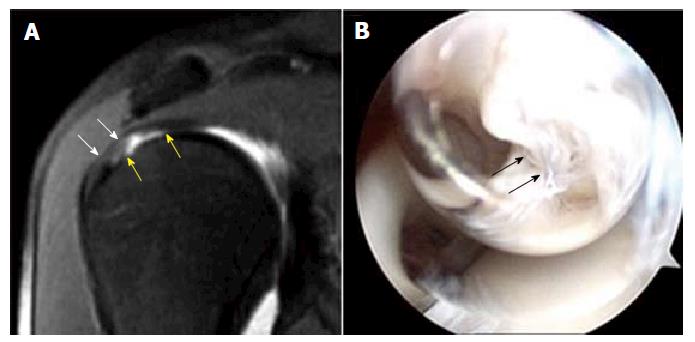Copyright
©The Author(s) 2017.
World J Radiol. Mar 28, 2017; 9(3): 126-133
Published online Mar 28, 2017. doi: 10.4329/wjr.v9.i3.126
Published online Mar 28, 2017. doi: 10.4329/wjr.v9.i3.126
Figure 1 Magnetic resonance arthrography of a C2 lesion of the supraspinatus tendon.
A: MRA, coronal TSE T1w fat sat. Full tear with fiber retraction of supraspinatus tendon. Yellow arrows show the bare area of foot print lesion (C2 lesion according to Snyder classification); B: Arthroscopic view. Dotted line shows the crescent shape lesion. MRA: Magnetic resonance arthrography.
Figure 2 Magnetic resonance arthrography of a C1 tear of the supraspinatus tendon.
A: MRA coronal, double echo steady state. Viewfinder shows the hyperintense signal in supraspinatus tendon, expression of full tear (C1 lesion according to Snyder classification); B: MRA Sagittal TSE T1w. Yellow arrows show the full tear (C1 lesion according to Snyder classification). White arrows show the degenerative tendon matrix, later removed by the surgeon; C: Arthroscopic view. White dotted line show a full, V-shape, tear of supraspinatus tendon completed to C2 according to Snyder classification by the surgeon. MRA: Magnetic resonance arthrography.
Figure 3 Magnetic resonance arthrography and arthroscopy of an A4 tear of the supraspinatus tendon.
A: MRA, coronal TSE T1w fat sat. The yellow arrows show the articular asymmetric profile, expression of erosion and partial tear of supraspinatus tendon (A4 lesion according to Snyder classification). White arrows show the regular bursal profile; B: Arthroscopic view. The black arrows show the mangy and flap of supraspinatus tendon. MAR: Magnetic resonance arthrography.
- Citation: Aliprandi A, Messina C, Arrigoni P, Bandirali M, Di Leo G, Longo S, Magnani S, Mattiuz C, Randelli F, Sdao S, Sardanelli F, Sconfienza LM, Randelli P. Reporting rotator cuff tears on magnetic resonance arthrography using the Snyder’s arthroscopic classification. World J Radiol 2017; 9(3): 126-133
- URL: https://www.wjgnet.com/1949-8470/full/v9/i3/126.htm
- DOI: https://dx.doi.org/10.4329/wjr.v9.i3.126











